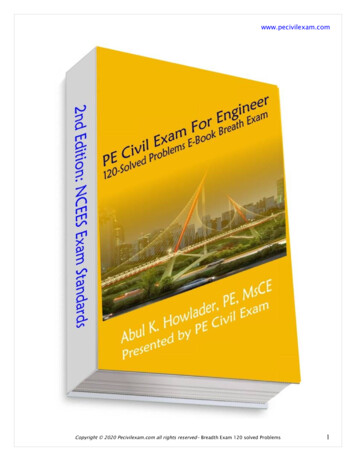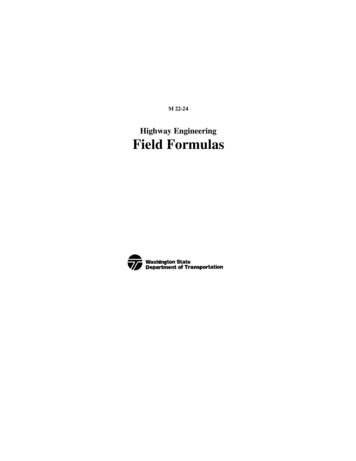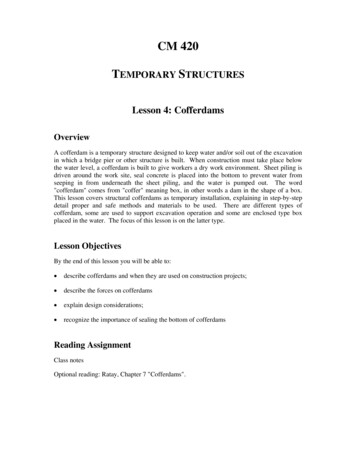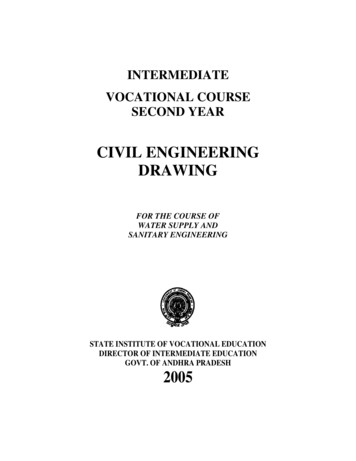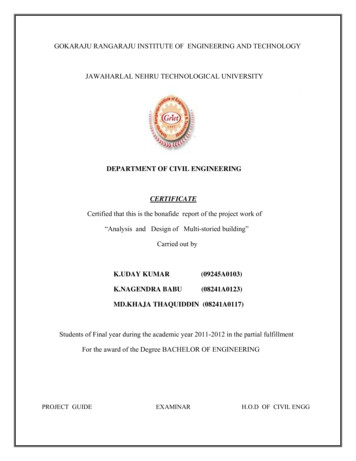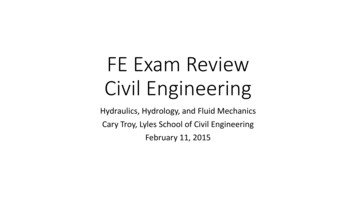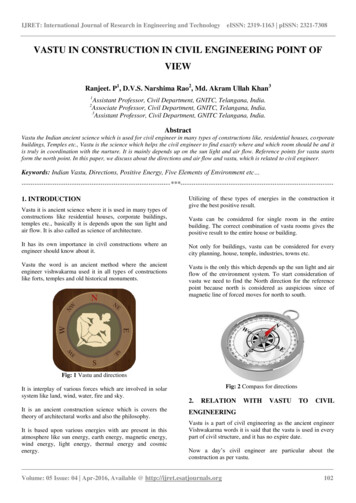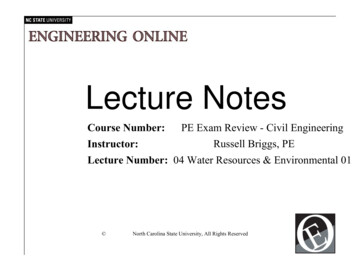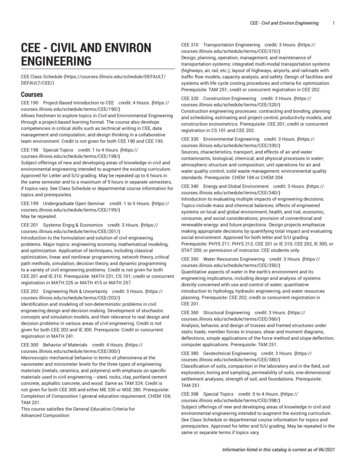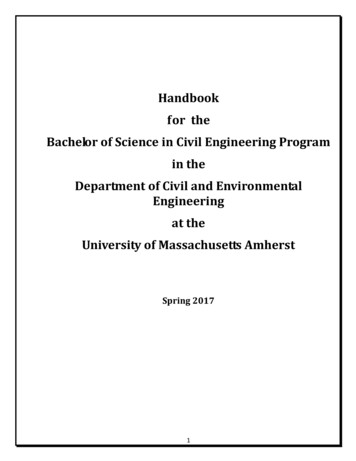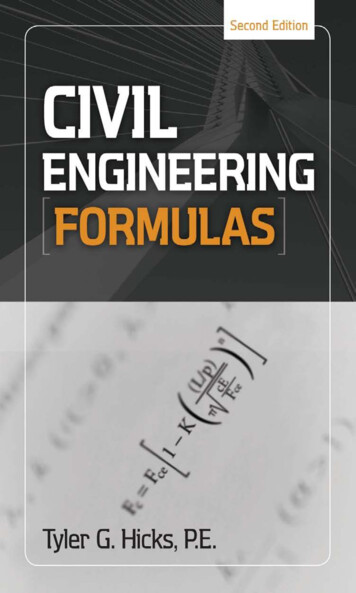
Transcription
CIVILENGINEERINGFORMULAS
ABOUT THE AUTHORTyler G. Hicks, P.E., is a consulting engineer and a successful engineering book author. He has worked in plant design and operationin a variety of industries, taught at several engineering schools, andlectured both in the United States and abroad. Mr. Hicks holds abachelor’s degree in Mechanical Engineering from Cooper UnionSchool of Engineering in New York. He is the author of more than100 books in engineering and related fields.
CIVILENGINEERINGFORMULASTyler G. Hicks, P.E.International Engineering AssociatesMember: American Society of Mechanical EngineersUnited States Naval InstituteSecond EditionNew York Chicago San Francisco Lisbon London MadridMexico City Milan New Delhi San Juan SeoulSingapore Sydney Toronto
Copyright 2010, 2002 by The McGraw-Hill Companies, Inc. All rights reserved. Except as permittedunder the United States Copyright Act of 1976, no part of this publication may be reproduced or distributed in any form or by any means, or stored in a database or retrieval system, without the prior writtenpermission of the publisher.ISBN: 978-0-07-161470-2MHID: 0-07-161470-2The material in this eBook also appears in the print version of this title: ISBN: 978-0-07-161469-6,MHID: 0-07-161469-9.All trademarks are trademarks of their respective owners. Rather than put a trademark symbol after everyoccurrence of a trademarked name, we use names in an editorial fashion only, and to the benefit of thetrademark owner, with no intention of infringement of the trademark. Where such designations appearin this book, they have been printed with initial caps.McGraw-Hill eBooks are available at special quantity discounts to use as premiums and salespromotions, or for use in corporate training programs. To contact a representative please e-mail us atbulksales@mcgraw-hill.com.Information contained in this work has been obtained by The McGraw-Hill Companies, Inc. (“McGrawHill”) from sources believed to be reliable. However, neither McGraw-Hill nor its authors guarantee theaccuracy or completeness of any information published herein, and neither McGraw-Hill nor its authorsshall be responsible for any errors, omissions, or damages arising out of use of this information. Thiswork is published with the understanding that McGraw-Hill and its authors are supplying informationbut are not attempting to render engineering or other professional services. If such services are required,the assistance of an appropriate professional should be sought.TERMS OF USEThis is a copyrighted work and The McGraw-Hill Companies, Inc. (“McGraw-Hill”) and its licensorsreserve all rights in and to the work. Use of this work is subject to these terms. Except as permitted underthe Copyright Act of 1976 and the right to store and retrieve one copy of the work, you may notdecompile, disassemble, reverse engineer, reproduce, modify, create derivative works based upon,transmit, distribute, disseminate, sell, publish or sublicense the work or any part of it withoutMcGraw-Hill’s prior consent. You may use the work for your own noncommercial and personal use; anyother use of the work is strictly prohibited. Your right to use the work may be terminated if you fail tocomply with these terms.THE WORK IS PROVIDED “AS IS.” McGRAW-HILL AND ITS LICENSORS MAKE NO GUARANTEES OR WARRANTIES AS TO THE ACCURACY, ADEQUACY OR COMPLETENESS OF ORRESULTS TO BE OBTAINED FROM USING THE WORK, INCLUDING ANY INFORMATIONTHAT CAN BE ACCESSED THROUGH THE WORK VIA HYPERLINK OR OTHERWISE, ANDEXPRESSLY DISCLAIM ANY WARRANTY, EXPRESS OR IMPLIED, INCLUDING BUT NOTLIMITED TO IMPLIED WARRANTIES OF MERCHANTABILITY OR FITNESS FOR A PARTICULAR PURPOSE. McGraw-Hill and its licensors do not warrant or guarantee that the functions containedin the work will meet your requirements or that its operation will be uninterrupted or error free. NeitherMcGraw-Hill nor its licensors shall be liable to you or anyone else for any inaccuracy, error or omission,regardless of cause, in the work or for any damages resulting therefrom. McGraw-Hill has noresponsibility for the content of any information accessed through the work. Under no circumstancesshall McGraw-Hill and/or its licensors be liable for any indirect, incidental, special, punitive, consequential or similar damages that result from the use of or inability to use the work, even if any of them hasbeen advised of the possibility of such damages. This limitation of liability shall apply to any claim orcause whatsoever whether such claim or cause arises in contract, tort or otherwise.
CONTENTSPreface xiAcknowledgments xiiiHow to Use This Book xvChapter 1. Conversion Factors for CivilEngineering PracticeChapter 2. Beam Formulas111Continuous Beams / 11Ultimate Strength of Continuous Beams / 46Beams of Uniform Strength / 52Safe Loads for Beams of Various Types / 53Rolling and Moving Loads / 53Curved Beams / 65Elastic Lateral Buckling of Beams / 69Combined Axial and Bending Loads / 72Unsymmetrical Bending / 73Eccentric Loading / 73Natural Circular Frequencies and Natural Periods ofVibration of Prismatic Beams / 74Torsion in Structural Members / 76Strain Energy in Structural Members / 76Fixed-End Moments in Beams / 79Chapter 3. Column Formulas81General Considerations / 81Short Columns / 81Eccentric Loads on Columns / 83Columns of Special Materials / 88Column Base Plate Design / 90American Institute of Steel ConstructionAllowable-Stress Design Approach / 91Composite Columns / 92Elastic Flexural Buckling of Columns / 94Allowable Design Loads for Aluminum Columns / 96Ultimate Strength Design Concrete Columns / 97Design of Axially Loaded Steel Columns / 102v
viCONTENTSChapter 4. Piles and Piling Formulas105Allowable Loads on Piles / 105Laterally Loaded Vertical Piles / 105Toe Capacity Load / 107Groups of Piles / 107Foundation-Stability Analysis / 109Axial-Load Capacity of Single Piles / 112Shaft Settlement / 112Shaft Resistance in Cohesionless Soils / 113Chapter 5. Concrete formulasReinforced Concrete / 115Water/Cementitious Materials Ratio / 115Job Mix Concrete Volume / 116Modulus of Elasticity of Concrete / 116Tensile Strength of Concrete / 117Reinforcing Steel / 117Continuous Beams and One-Way Slabs / 117Design Methods for Beams,Columns, and Other Members / 118Properties in the Hardened State / 127Tension Development Lengths / 128Compression Development Lengths / 128Crack Control of Flexural Members / 128Required Strength / 129Deflection Computations and Criteriafor Concrete Beams / 130Ultimate-Strength Design of Rectangular Beams withTension Reinforcement Only / 130Working-Stress Design of Rectangular Beams withTension Reinforcement Only / 133Ultimate-Strength Design of RectangularBeams with Compression Bars / 135Working-Stress Design of RectangularBeams with Compression Bars / 136Ultimate-Strength Design of I- and T-beams / 138Working-Stress Design of I- and T-beams / 138Ultimate-Strength Design for Torsion / 140Working-Stress Design for Torsion / 141Flat-Slab Construction / 142Flat-Plate Construction / 142Shear in Slabs / 145Column Moments / 146Spirals / 147Braced and Unbraced Frames / 147Shear Walls / 148Concrete Gravity Retaining Walls / 150Cantilever Retaining Walls / 153Wall Footings / 155115
CONTENTSChapter 6. Timber Engineering Formulasvii157Grading of Lumber / 157Size of Lumber / 157Bearing / 159Beams / 159Columns / 160Combined Bending and Axial Load / 161Compression at Angle to Grain / 161Recommendations of the Forest Products Laboratory / 162Compression on Oblique Plane / 163Adjustment Factors for Design Values / 164Fasteners for Wood / 169Adjustment of Design Values forConnections with Fasteners / 171Roof Slope to Prevent Ponding / 172Bending and Axial Tension / 173Bending and Axial Compression / 173Solid Rectangular or Square Columns with Flat Ends / 174Chapter 7. Surveying Formulas177Units of Measurement / 177Theory of Errors / 178Measurement of Distance with Tapes / 179Vertical Control / 182Stadia Surveying / 183Photogrammetry / 184Chapter 8. Soil and Earthwork FormulasPhysical Properties of Soils / 185Index Parameters for Soils / 186Relationship of Weights and Volumes in Soils / 186Internal Friction and Cohesion / 188Vertical Pressures in Soils / 188Lateral Pressures in Soils,Forces on Retaining Walls / 189Lateral Pressure of Cohesionless Soils / 190Lateral Pressure of Cohesive Soils / 191Water Pressure / 191Lateral Pressure from Surcharge / 191Stability of Slopes / 192Bearing Capacity of Soils / 192Settlement under Foundations / 193Soil Compaction Tests / 193Compaction Equipment / 195Formulas for Earthmoving / 196Scraper Production / 197Vibration Control in Blasting / 198185
viiiCONTENTSChapter 9. Building and Structures Formulas207Load-and-Resistance Factor Designfor Shear in Buildings / 207Allowable-Stress Design for Building Columns / 208Load-and-Resistance Factor Design for Building Columns / 209Allowable-Stress Design for Building Beams / 209Load-and-Resistance Factor Design for Building Beams / 211Allowable-Stress Design for Shear in Buildings / 214Stresses in Thin Shells / 215Bearing Plates / 216Column Base Plates / 217Bearing on Milled Surfaces / 218Plate Girders in Buildings / 219Load Distribution to Bents and Shear Walls / 220Combined Axial Compression or Tension and Bending / 221Webs under Concentrated Loads / 222Design of Stiffeners under Loads / 224Fasteners in Buildings / 225Composite Construction / 225Number of Connectors Requiredfor Building Construction / 226Ponding Considerations in Buildings / 228Lightweight Steel Construction / 228Choosing the Most Economic Structural Steel / 239Steel Carbon Content and Weldability / 240Statically Indeterminate Forces and Momentsin Building Structures / 241Roof Live Loads / 244Chapter 10. Bridge and Suspension-Cable FormulasShear Strength Design for Bridges / 249Allowable-Stress Design for Bridge Columns / 250Load-and-Resistance Factor Design for Bridge Columns / 250Additional Bridge Column Formulas / 251Allowable-Stress Design for Bridge Beams / 254Stiffeners on Bridge Girders / 255Hybrid Bridge Girders / 256Load-Factor Design for Bridge Beams / 256Bearing on Milled Surfaces / 258Bridge Fasteners / 258Composite Construction in Highway Bridges / 259Number of Connectors in Bridges / 261Allowable-Stress Design for Shear in Bridges / 262Maximum Width/Thickness Ratios for CompressionElements for Highway Bridges / 263Suspension Cables / 263General Relations for Suspension Cables / 267Cable Systems / 272Rainwater Accumulation and Drainage on Bridges / 273249
CONTENTSixChapter 11. Highway and Road Formulas275Circular Curves / 275Parabolic Curves / 277Highway Curves and Driver Safety / 278Highway Alignments / 279Structural Numbers for Flexible Pavements / 281Transition (Spiral) Curves / 284Designing Highway Culverts / 285American Iron and Steel Institute (AISI)Design Procedure / 286Chapter 12. Hydraulics and Waterworks FormulasCapillary Action / 291Viscosity / 291Pressure on Submerged Curved Surfaces / 295Fundamentals of Fluid Flow / 296Similitude for Physical Models / 298Fluid Flow in Pipes / 300Pressure (Head) Changes Caused by PipeSize Change / 306Flow through Orifices / 308Fluid Jets / 310Orifice Discharge into Diverging Conical Tubes / 311Water Hammer / 312Pipe Stresses Perpendicularto the Longitudinal Axis / 312Temperature Expansion of Pipe / 313Forces due to Pipe Bends / 313Culverts / 315Open-Channel Flow / 318Manning’s Equation for Open Channels / 320Hydraulic Jump / 321Nonuniform Flow in Open Channels / 323Weirs / 329Flow over Weirs / 330Prediction of Sediment-Delivery Rate / 332Evaporation and Transpiration / 332Method for Determining Runoff for MinorHydraulic Structures / 333Computing Rainfall Intensity / 333Groundwater / 334Water Flow for Fire Fighting / 335Flow from Wells / 335Economical Sizing of Distribution Piping / 336Venturi Meter Flow Computation / 336Hydroelectric Power Generation / 337Pumps and Pumping Systems / 338Hydraulic Turbines / 344Dams / 348291
CONTENTSxChapter 13. Stormwater, Sewage, SanitaryWastewater, and Environmental ProtectionDetermining Storm Water Flow / 361Flow Velocity in Straight Sewers / 361Design of a Complete-Mix Activated Sludge Reactor / 364Design of a Circular Settling Tank / 368Sizing a Polymer Dilution/Feed System / 369Design of a Solid-Bowl Centrifuge for Sludge Dewatering / 369Design of a Trickling Filter Using the NRC Equations / 371Design of a Rapid-Mix Basin and Flocculation Basin / 373Design of an Aerobic Digester / 374Design of a Plastic Media Trickling Filter / 375Design of an Anaerobic Digestor / 377Design of a Chlorination System for Wastewater Disinfection / 379Sanitary Sewer System Design / 380Design of an Aerated Grit Chamber / 383Index385361
PREFACEThe second edition of this handy book presents some 2,500 formulas and calculation guides for civil engineers to help them in the design office, in the field,and on a variety of construction jobs, anywhere in the world. These formulasand guides are also useful to design drafters, structural engineers, bridge engineers, foundation builders, field engineers, professional-engineer license examination candidates, concrete specialists, timber-structure builders, and studentsin a variety of civil engineering pursuits.The book presents formulas needed in 13 different specialized branches ofcivil engineering—beams and girders, columns, piles and piling, concretestructures, timber engineering, surveying, soils and earthwork, building structures, bridges, suspension cables, highways and roads, hydraulics and openchannel flow, stormwater, sewage, sanitary wastewater, and environmentalprotection. Some 500 formulas and guides have been added to this second edition of the book.Key formulas are presented for each of the major topics listed above.Each formula is explained so the engineer, drafter, or designer knows how,where, and when to use the formula in professional work. Formula units aregiven in both the United States Customa
Chapter 6. Timber Engineering Formulas 157 Grading of Lumber / 157 Size of Lumber / 157 Bearing / 159 Beams / 159 Columns / 160 Combined Bending and Axial Load / 161 Compression at Angle to Grain / 161 Recommendations of the Forest Products Laboratory / 162 Compression on Oblique Plane / 163 Adjustment Factors for Design Values / 164 Fasteners for Wood / 169 Adjustment of Design Values for
